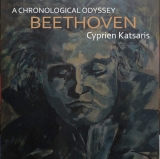 Beethoven: A Chronological Odyssey; Ludwig van Beethoven: Variations on a March by Dressler, WoO 63 + Sonata WoO 47/1+ Zwei Präludien, Op. 39 + Musik zu einem Ritterballet, WoO 1 + Piano Sonata No. 1, Op. 2/1 + Rondo alla ingharese quasi un capriccio, Op. 129 + Grande sonate pour le piano after String Trio, Op. 3 (Arr. Beethoven?/Diabelli?) + Cello Sonata No. 2 Op. 5/2 (Rondo. Allegro, Arr. Louis Winkler) + Sonatina for Mandolin and Harpsichord in C Major, WoO 44a (Arr. Vladimir M. Blok) + Piano Sonata No. 5 in C Minor, Op. 10/1 + Piano Sonata No. 10, Op. 14/2 + Septet Op. 20 (Tempo di Menuetto - Trio, Arr. Liszt) + String Quartet No. 6, Op. 18/6 (Adagio ma non troppo, Arr. Saint-Saëns) + String Quartet No. 4, Op. 18/4 (Allegro ma non tanto, Arr. Gustav Rösler) + Violin Sonata No. 5, Op. 24 (Spring, Arr. Winkler) + Serenade, Op. 25 (Arr. Winkler) + Piano Sonata No. 14, Op. 27/2 (Moonlight) + Violin Sonata No. 7, Op. 30/2 (Adagio cantabile, Arr. Winkler) + Bagatelle, Op. 33/1 + 12 Contredanses, WoO 14 (No. 12, Contredanse - Trio, Arr. Ludwig/Kaspar Karl von Beethoven) + Piano Sonata No. 17, Op. 31/2 (The Tempest) + Violin Sonata No. 9, Op. 47 (Kreutzer, Arr. Carl Czerny) + Piano Sonata No. 23, Op. 57 (Appassionata) + Violin Concerto in D Major, Op. 61: (Rondo. Allegro, Arr. Franz Kullak) + 32 Variations on an Original Theme in C Minor, WoO 80 + Fantasia in G Minor, Op. 77 + March in F Major, WoO 18 (Yorckscher March, Arr. Beethoven) + Piano Sonata No. 24 in F-Sharp Major, Op. 78 (A Thérèse) + Piano Sonata No. 32 op. 111 + Symphony No. 9 in D Minor, Op. 125 (Adagio molto e cantabile - Andante moderato, Arr. R. Wagner) + String Quartet No. 16 in F Major, Op. 135 (Lento assai, cantante e tranquillo - Più lento, Arr. Mussorgsky) + String Quintet in C Major, WoO 62 (Introduction. Andante maestoso, Arr. A.Diabelli) + Musikalischer Scherz (Wir irren allesamt, nur jeder irret anders), WoO 198; Cyprien Katsaris, Klavier; 6 CDs Piano 21 P21060; Aufnahmen 2016/2019, Veröffentlichung 06/2020 (o.A.) - Rezension von Remy Franck
Beethoven: A Chronological Odyssey; Ludwig van Beethoven: Variations on a March by Dressler, WoO 63 + Sonata WoO 47/1+ Zwei Präludien, Op. 39 + Musik zu einem Ritterballet, WoO 1 + Piano Sonata No. 1, Op. 2/1 + Rondo alla ingharese quasi un capriccio, Op. 129 + Grande sonate pour le piano after String Trio, Op. 3 (Arr. Beethoven?/Diabelli?) + Cello Sonata No. 2 Op. 5/2 (Rondo. Allegro, Arr. Louis Winkler) + Sonatina for Mandolin and Harpsichord in C Major, WoO 44a (Arr. Vladimir M. Blok) + Piano Sonata No. 5 in C Minor, Op. 10/1 + Piano Sonata No. 10, Op. 14/2 + Septet Op. 20 (Tempo di Menuetto - Trio, Arr. Liszt) + String Quartet No. 6, Op. 18/6 (Adagio ma non troppo, Arr. Saint-Saëns) + String Quartet No. 4, Op. 18/4 (Allegro ma non tanto, Arr. Gustav Rösler) + Violin Sonata No. 5, Op. 24 (Spring, Arr. Winkler) + Serenade, Op. 25 (Arr. Winkler) + Piano Sonata No. 14, Op. 27/2 (Moonlight) + Violin Sonata No. 7, Op. 30/2 (Adagio cantabile, Arr. Winkler) + Bagatelle, Op. 33/1 + 12 Contredanses, WoO 14 (No. 12, Contredanse - Trio, Arr. Ludwig/Kaspar Karl von Beethoven) + Piano Sonata No. 17, Op. 31/2 (The Tempest) + Violin Sonata No. 9, Op. 47 (Kreutzer, Arr. Carl Czerny) + Piano Sonata No. 23, Op. 57 (Appassionata) + Violin Concerto in D Major, Op. 61: (Rondo. Allegro, Arr. Franz Kullak) + 32 Variations on an Original Theme in C Minor, WoO 80 + Fantasia in G Minor, Op. 77 + March in F Major, WoO 18 (Yorckscher March, Arr. Beethoven) + Piano Sonata No. 24 in F-Sharp Major, Op. 78 (A Thérèse) + Piano Sonata No. 32 op. 111 + Symphony No. 9 in D Minor, Op. 125 (Adagio molto e cantabile - Andante moderato, Arr. R. Wagner) + String Quartet No. 16 in F Major, Op. 135 (Lento assai, cantante e tranquillo - Più lento, Arr. Mussorgsky) + String Quintet in C Major, WoO 62 (Introduction. Andante maestoso, Arr. A.Diabelli) + Musikalischer Scherz (Wir irren allesamt, nur jeder irret anders), WoO 198; Cyprien Katsaris, Klavier; 6 CDs Piano 21 P21060; Aufnahmen 2016/2019, Veröffentlichung 06/2020 (o.A.) - Rezension von Remy Franck

Cyprien Katsaris ist immer darauf aus, originelle Programme zu spielen, und so war zu erwarten, dass er zum Beethoven-Jahr einen höchst originellen Beitrag leisten würde. Auf 6 CDs spielt er 41 Werke in chronologischer Reihenfolge, von den Dressler-Variationen des 11-Jährigen bis zum Musikalischen Scherz von 1826. Neben acht Sonaten, darunter die Mondscheinsonate, Der Sturm, Appassionata, A Thérèse und Op. 111, gibt es eine ganze Reihe an Transkriptionen von Sätzen aus Kammermusikwerken von Beethoven selber, von Carl Czerny, Anton Diabelli, Modest Mussorgsky, Richard Wagner, Louis Winkler, Camille Saint-Saëns und Franz Liszt.
Der 69-jährige Katsaris braucht niemandem mehr etwas zu beweisen. Er stellt sein großes Talent und seine Autorität mit Interpretationen unter Beweis, die zwar sehr persönlich sind, aber nie überzogen, recherchiert oder gar manieriert. Ob in den Transkriptionen oder in den Sonaten, seine Ansichten sind bewundernswert solide ausgearbeitet und schlüssig.
In den Bearbeitungen gelingt es Katsaris, die Musik aufzuwerten und sie originell werden zu lassen. Sein Spiel ist nie übermäßig laut, nie rasant um des Schnelligkeitseffekts wegen und über die sechs Schallplatten hinweg sehr differenziert, immer spontan und entsprechend attraktiv. Da kommt keine Müdigkeit auf, es gibt keinerlei Flachheit, weil der flexible Vortrag mit Nuancen, Kontrasten, viel artikulatorischem Feingefühl und einem genuinen architektonischen Gespür unbestreitbar spannend ist, manchmal auch mit phänomenaler Virtuosität und fein regulierter Fingerakrobatik gewürzt, deren musikalische Qualität mit einer nie nachlassenden Natürlichkeit verbunden ist. Für die gestochen scharfe Pianistik sind die 32 Variationen ein gutes Beispiel. Und wenn in diesen Variationen die Virtuosität fasziniert, dann tut das im von Richard Wagner transkribierten Adagio aus der Neunten Symphonie die bewegende Noblesse.
Die Sonaten sind in ihren eloquenten Interpretationen nicht weniger gelungen. Katsaris’ dynamische Abstufungen und das viril drängende Finale in der Mondscheinsonate sind ebenso bemerkenswert wie die Rhetorik der Sturm-Sonate, die Kohärenz der Appassionata oder die rundum überzeugende Dramaturgie im Opus 111.
Das Textheft enthält zu jedem Werk einen kurzen Einführungstext von Katsaris selber und detaillierte Tracklisten, leider ohne Angabe der Spieldauer.
Cyprien Katsaris is always eager to play original programmes, so it was to be expected that he would make a highly original contribution to the Beethoven Year. On 6 CDs he plays 41 works in chronological order, from the 11-year-old’s Dressler Variations to the Musical Joke of 1826. In addition to eight sonatas, including the Moonlight Sonata, The Tempest, Appassionata, A Thérèse and Op. 111, there is a whole series of transcriptions of movements from chamber music works by Beethoven himself, by Carl Czerny, Anton Diabelli, Modest Mussorgsky, Richard Wagner, Louis Winkler, Camille Saint-Saëns, and Franz Liszt.
69-year-old Katsaris no longer needs to prove anything to anyone. He shows his great talent and authority with interpretations that are very personal, but never overdone, researched or even mannered. Whether in the transcriptions or in the sonatas, his views are admirably well elaborated and coherent.
In the arrangements, Katsaris succeeds in enhancing the music and making it original. His playing is never excessively loud, never fast-paced just for the speed effect, and across the six discs it is very differentiated, always spontaneous and correspondingly attractive. There is no fatigue, there is no flatness whatsoever, because the flexible performance is undeniably exciting with nuances, contrasts, a great deal of articulatory sensitivity and a genuine architectural flair, sometimes spiced with phenomenal virtuosity and finely regulated finger acrobatics, whose musical quality is combined with the most subtle naturalness. A good example for the pianist’s razor-sharp pianism are the 32 Variations. Among the slower movements, let’s point out the Adagio from the Ninth Symphony, transcribed by Richard Wagner. It is carefully played with moving noblesse.
The sonatas are no less successful in their eloquent interpretations. Katsaris’ dynamic gradations and the virile, urgent finale in the Moonlight Sonata are as remarkable as the rhetoric of the Tempest Sonata, the coherence of the Appassionata or the all-round convincing dramaturgy in Opus 111.
The text booklet contains a short introductory text for each work by Katsaris himself and detailed track lists, unfortunately without indication of the playing time.























